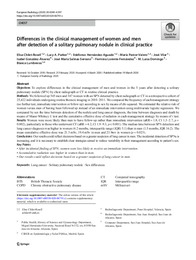Por favor, use este identificador para citar o enlazar este ítem:
https://hdl.handle.net/11000/30515Registro completo de metadatos
| Campo DC | Valor | Lengua/Idioma |
|---|---|---|
| dc.contributor.author | Chilet Rosell, Elisa | - |
| dc.contributor.author | Parker, Lucy Anne | - |
| dc.contributor.author | Hernández-Aguado, Ildefonso | - |
| dc.contributor.author | Pastor-Valero, Maria | - |
| dc.contributor.author | Vilar, José | - |
| dc.contributor.author | González-Álvarez, Isabel | - |
| dc.contributor.author | Salinas Serrano, Jose Maria | - |
| dc.contributor.author | Lorente-Fernández, Fermina | - |
| dc.contributor.author | Domingo, M. Luisa | - |
| dc.contributor.author | Lumbreras, Blanca | - |
| dc.contributor.other | Departamentos de la UMH::Salud Pública, Historia de la Ciencia y Ginecología | es_ES |
| dc.date.accessioned | 2024-01-12T09:06:24Z | - |
| dc.date.available | 2024-01-12T09:06:24Z | - |
| dc.date.created | 2020-03 | - |
| dc.identifier.citation | European Radiology (2020) 30 | es_ES |
| dc.identifier.issn | 1432-1084 | - |
| dc.identifier.issn | 0938-7994 | - |
| dc.identifier.uri | https://hdl.handle.net/11000/30515 | - |
| dc.description.abstract | Objectives To explore differences in the clinical management of men and women in the 5 years after detecting a solitary pulmonary nodule (SPN) by chest radiograph or CT in routine clinical practice. Methods We followed up 545 men and 347 women with an SPN detected by chest radiograph or CT in a retrospective cohort of 25,422 individuals undergoing routine thoracic imaging in 2010–2011.We compared the frequency of each management strategy (no further test, immediate intervention or follow up) according to sex by means of chi-squared.We estimated the relative risk of women versus men of having been followed up instead of an immediate intervention using multivariate logistic regression. We compared by sex the time between detection of the nodule and lung cancer diagnosis, the time between diagnosis and death by means of Mann-Whitney U test and the cumulative effective dose of radiation in each management strategy by means of t test. Results Women were more likely than men to have follow-up rather than immediate intervention (aRR = 1.8, CI 1.3–2.7, p = 0.002), particularly in those who underwent CT (aRR = 4.2, CI 1.9–9.3, p < 0.001). The median time between SPN detection and lung cancer diagnosis was higher in women (4.2 months, interquartile range (IQR) 5.1) than in men (1.5 months, IQR 16.2). The mean cumulative effective dose was 21.3 mSv, 19.4 mSv in men and 23.9mv in women (p = 0.023). Conclusions Our results could reflect decisions based on a greater suspicion of lung cancer in men. The incidental detection of SPNs is increasing, and it is necessary to establish clear strategies aimed to reduce variability in their management according to patient’s sex. | es_ES |
| dc.format | application/pdf | es_ES |
| dc.format.extent | 8 | es_ES |
| dc.language.iso | eng | es_ES |
| dc.publisher | Springer | es_ES |
| dc.rights | info:eu-repo/semantics/openAccess | es_ES |
| dc.rights | Attribution-NonCommercial-NoDerivatives 4.0 Internacional | * |
| dc.rights.uri | http://creativecommons.org/licenses/by-nc-nd/4.0/ | * |
| dc.subject | Lung cancer | es_ES |
| dc.subject | Solitary pulmonary nodule | es_ES |
| dc.subject | Sex differences | es_ES |
| dc.subject.other | CDU::6 - Ciencias aplicadas::61 - Medicina | es_ES |
| dc.title | Differences in the clinical management of women and men after detection of a solitary pulmonary nodule in clinical practice | es_ES |
| dc.type | info:eu-repo/semantics/article | es_ES |
| dc.relation.publisherversion | https://doi.org/10.1007/s00330-020-06791-z | es_ES |

Ver/Abrir:
7-Chilet-Rosell2020_Article_DifferencesInTheClinicalManage.pdf
251,49 kB
Adobe PDF
Compartir:
 La licencia se describe como: Atribución-NonComercial-NoDerivada 4.0 Internacional.
La licencia se describe como: Atribución-NonComercial-NoDerivada 4.0 Internacional.
.png)